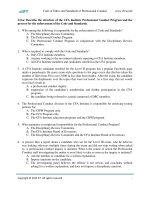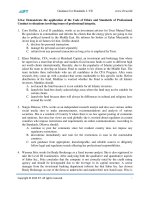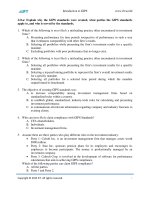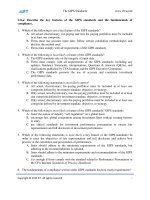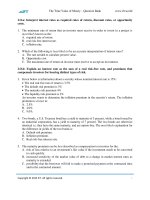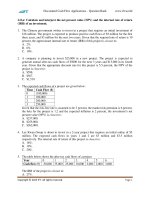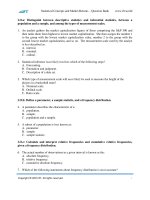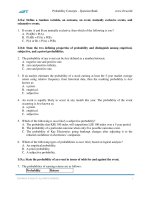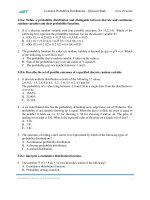CFA 2018 quest bank 02 derivative investments o te and credit derivatives
Bạn đang xem bản rút gọn của tài liệu. Xem và tải ngay bản đầy đủ của tài liệu tại đây (423.48 KB, 68 trang )
Derivative Investments: Options, Swaps, and Interest Rate and Credit
Derivatives
Test ID: 7441879
Question #1 of 172
Question ID: 464184
In order to compute the implied asset price volatility for a particular option, an investor:
ᅞ A) must have a series of asset prices.
ᅚ B) must have the market price of the option.
ᅞ C) does not need to know the risk-free rate.
Explanation
In order to compute the implied volatility we need the risk-free rate, the current asset price, the time to expiration, the exercise
price, and the market price of the option.
Question #2 of 172
Question ID: 464214
The fixed-rate payer in an interest-rate swap has a position equivalent to a series of:
ᅞ A) long interest-puts and short interest-rate calls.
ᅚ B) short interest-rate puts and long interest-rate calls.
ᅞ C) long interest-rate puts and calls.
Explanation
The fixed-rate payer has profits when short rates rise and losses when short rates fall, equivalent to writing puts and buying
calls.
Question #3 of 172
Question ID: 464097
Referring to put-call parity, which one of the following alternatives would allow you to create a synthetic European call option?
ᅞ A) Sell the stock; buy a European put option on the same stock with the same
exercise price and the same maturity; invest an amount equal to the present
value of the exercise price in a pure-discount riskless bond.
ᅚ B) Buy the stock; buy a European put option on the same stock with the same exercise
price and the same maturity; short an amount equal to the present value of the
exercise price worth of a pure-discount riskless bond.
ᅞ C) Buy the stock; sell a European put option on the same stock with the same exercise
price and the same maturity; short an amount equal to the present value of the
exercise price worth of a pure-discount riskless bond.
Explanation
According to put-call parity we can write a European call as: C0 = P0 + S0 - X/(1+Rf)T
We can then read off the right-hand side of the equation to create a synthetic position in the call. We would need to buy the
European put, buy the stock, and short or issue a riskless pure-discount bond equal in value to the present value of the
exercise price.
Questions #4-9 of 172
Steve Miller is a senior fixed income trader for a large hedge fund based in New York. Miller has recently hired C.D. Johnson
to assist Miller in implementing some derivative-based trades. Miller would like to ensure that Johnson understands the basics
of interest rate derivatives before allowing him to be involved into some more complicated trading strategies. Miller creates a
hypothetical bond scenario for Johnson to analyze in order for him to evaluate Johnson's expertise in the area. Miller instructs
Johnson to consider the London Interbank Offered Rate (LIBOR) interest rate environment in Table 1.
Table 1
90-Day LIBOR Forward Rates and Implied Spot Rates
Period (in months) LIBOR Forward Rates Implied Spot Rates
0×3
5.500%
5.5000%
3×6
5.750%
5.6250%
6×9
6.000%
5.7499%
9 × 12
6.250%
5.8749%
12 × 15
7.000%
6.0997%
15 × 18
7.000%
6.2496%
48 × 51
8.100%
7.1228%
51 × 54
8.200%
7.1826%
54 × 57
8.300%
7.2413%
57 × 60
8.400%
7.2992%
60 × 63
8.500%
7.3563%
63 × 66
8.600%
7.4127%
66 × 69
8.700%
7.4686%
69 × 72
8.800%
7.5240%
72 × 75
8.900%
7.5789%
75 × 78
9.000%
7.6335%
78 × 81
9.100%
7.6877%
81 × 84
9.200%
7.7416%
84 × 87
9.300%
7.7953%
87 × 90
9.400%
7.8487%
Miller suggests to Johnson to examine the instruments shown in Table 2 using the information in Table 1. Miller instructs
Johnson to use 0.25 years for each quarter and to not concern himself with actual day counts.
Table 2
Interest Rate Instruments
Dollar Amount of Floating Rate
$30,000,000
Bond
Floating Rate Bond Spread over
0.50%
LIBOR
Time to Maturity (years)
1
Cap Strike Rate
6.00%
Floor Strike Rate
5.00%
Interest Payments
quarterly
Question #4 of 172
Question ID: 464266
Johnson wants to evaluate the effect of an increase in rates on the inception value of a plain vanilla pay, fixed interest rate
swap. Specifically, if interest rates increase across all maturities in Table 1, how would the inception value of the swap be
affected? The inception value of the swap would:
ᅞ A) decrease.
ᅚ B) stay the same.
ᅞ C) increase.
Explanation
The value stays the same because the inception value of all plain vanilla interest rates swaps is zero by design.
An increase would, however, be correct for an existing pay fixed swap. The counterparty receives the floating rate while paying
the fixed rate. Therefore, it would receive a higher interest rate but would still have to pay the same fixed interest rate.
Therefore, the value of the swap would increase. (Study Session 17, LOS 54.a, c)
Question #5 of 172
Question ID: 464267
Miller asks Johnson to hedge a hypothetical short position in the floating rate bond in Table 2. Which of the following is the
best hedge for this position?
ᅞ A) Sell an interest rate cap.
ᅚ B) Buy an interest rate cap.
ᅞ C) Buy an interest rate floor.
Explanation
An interest rate cap provides a positive payoff when interest rates are above the cap strike rate. Therefore, the buyer of this instrument is
able to hedge himself against rising interest rates.
Incorrect answer explanations:
Selling an interest rate cap is not a hedge against rising interest rates.
Buying an interest rate floor hedges the risk of decreasing interest rates.
(Study Session 17, LOS 55.a)
Question #6 of 172
Question ID: 464268
Miller now asks Johnson to compute the payoff of the cap and floor in Table 2 assuming that LIBOR has risen to 7% at
expiration. Specifically, Miller wants Johnson to determine the net payoff of the corresponding short collar (buying the floor and
selling the cap) for the total outstanding amount of the floating rate bond. Which of the following is the closest to Johnson's
answer?
ᅞ A) $300,000.
ᅚ B) -$300,000.
ᅞ C) −$450,000.
Explanation
The floor expires worthless while the cap is exercised and the seller has to pay the difference between the cap strike rate and
LIBOR which is 1% in this case. Hence the calculation is as follows:
Net Payoff = (6.00% − (7.00%)) × $30,000,000 = −$300,000
The answer −$450,000 is incorrect because the payoff is determined by the LIBOR rate, not by the spread over LIBOR for the
floating rate bond. (Study Session 17, LOS 55.b)
Question #7 of 172
Question ID: 464269
Next, Miller asks Johnson to determine the net payoff of the corresponding long collar (buying the cap and selling the floor) for
the total outstanding amount of the floating rate bond. Assume that LIBOR has risen to 8% at expiration. Which of the following
is the closest to Johnson's answer?
ᅞ A) −$600,000.
ᅞ B) $900,000.
ᅚ C) $600,000.
Explanation
The floor expires worthless while the cap is exercised and the seller has to pay the difference between the cap strike rate and
LIBOR which is 2% in this case. Hence the calculation is as follows:
Net Payoff = (8.00% − (6.00%)) × $30,000,000 = $600,000
(Study Session 17, LOS 55.b)
Question #8 of 172
Question ID: 464270
Miller asks Johnson which of the following strategies allows an investor to benefit from both increasing and decreasing interest
rates?
ᅚ A) Buy an at the money cap and an at the money floor.
ᅞ B) Sell an at the money cap and an at the money floor.
ᅞ C) Buy an at the money cap and sell an at the money floor.
Explanation
This is a straddle on interest rates. The cap provides a positive payoff when interest rates rise and the floor provides a positive
payoff when interest rates fall.
Incorrect answer explanations:
Sell an at the money cap and an at the money floor. In this case the investor would suffer from increasing and decreasing
interest rates since the caplets and floorlets would be exercised against him.
Buy an at the money cap and sell an at the money floor. In this case the investor would suffer from decreasing interest
rates since the floorlets would be exercised against him.
(Study Session 17, LOS 55.a)
Question #9 of 172
Question ID: 464271
Johnson now considers the floating rate bond shown in Table 2. Specifically, Johnson considers this note from the perspective
of the issuer. If the issuer decided to hedge the interest rate risk associated with this liability which of the following is the most
appropriate hedge?
ᅞ A) Buying an interest rate floor.
ᅞ B) Selling an interest rate floor.
ᅚ C) Selling Eurodollar futures.
Explanation
If a short position in Eurodollar futures is added to the existing liability in the correct amount, the interest risk is hedged.
Incorrect answer explanations:
Buying an interest rate floor is a hedge against declining interest rates if one has a long position in a floating rate bond.
Selling an interest rate floor is not a hedge against changing interest rates.
(Study Session 17, LOS 55.a)
Question #10 of 172
For an interest rate swap, the swap spread is the difference between the:
ᅚ A) swap rate and the corresponding Treasury rate.
ᅞ B) fixed rate and the floating rate in a given period.
ᅞ C) average fixed rate and the average floating rate over the life of the contract.
Explanation
The swap spread is the swap rate minus the corresponding Treasury rate.
Question ID: 464254
Question #11 of 172
Question ID: 464208
The floating-rate payer in a simple interest-rate swap has a position that is equivalent to:
ᅞ A) a series of long forward rate agreements (FRAs).
ᅚ B) a series of short FRAs.
ᅞ C) issuing a floating-rate bond and a series of long FRAs.
Explanation
The floating-rate payer has a liability/gain when rates increase/decrease above the fixed contract rate; the short position in an
FRA has a liability/gain when rates increase/decrease above the contract rate.
Question #12 of 172
Question ID: 464119
For a change in which of the following inputs into the Black-Scholes-Merton option pricing model will the direction of the
change in a put's value and the direction of the change in a call's value be the same?
ᅚ A) Volatility.
ᅞ B) Exercise price.
ᅞ C) Risk-free rate.
Explanation
A decrease/increase in the volatility of the price of the underlying asset will decrease/increase both put values and call values.
A change in the values of the other inputs will have opposite effects on the values of puts and calls.
Question #13 of 172
Question ID: 464227
Consider a fixed-rate semiannual-pay equity swap where the equity payments are the total return on a $1 million portfolio and
the following information:
180-day LIBOR is 4.2%
360-day LIBOR is 4.5%
Div. yield on the portfolio = 1.2%
What is the fixed rate on the swap?
ᅞ A) 4.5143%.
ᅞ B) 4.3232%.
ᅚ C) 4.4477%.
Explanation
= 0.022239 × 2 = 4.4477%
Question #14 of 172
Question ID: 464235
An investor who anticipates the need to exit a pay-fixed interest rate swap prior to expiration might:
ᅞ A) buy a payer swaption.
ᅚ B) buy a receiver swaption.
ᅞ C) sell a payer swaption.
Explanation
A receiver swaption will, if exercised, provide a fixed payment to offset the investor's fixed obligation, and allow him to pay
floating rates if they decrease.
Question #15 of 172
Question ID: 464168
Compared to the value of a call option on a stock with no dividends, a call option on an identical stock expected to pay a
dividend during the term of the option will have a:
ᅞ A) higher value only if it is an American style option.
ᅞ B) lower value only if it is an American style option.
ᅚ C) lower value in all cases.
Explanation
An expected dividend during the term of an option will decrease the value of a call option.
Question #16 of 172
Question ID: 464212
Writing a series of interest-rate puts and buying a series of interest-rate calls, all at the same exercise rate, is equivalent to:
ᅞ A) a short position in a series of forward rate agreements.
ᅚ B) being the fixed-rate payer in an interest rate swap.
ᅞ C) being the floating-rate payer in an interest rate swap.
Explanation
A short position in interest rate puts will have a negative payoff when rates are below the exercise rate; the calls will have
positive payoffs when rates exceed the exercise rate. This mirrors the payoffs of the fixed-rate payer who will receive positive
net payments when settlement rates are above the fixed rate.
Question #17 of 172
Question ID: 464182
Which of the following statements regarding an option's price is CORRECT? An option's price is:
ᅞ A) a decreasing function of the underlying asset's volatility when it has a long
time remaining until expiration and an increasing function of its volatility if the
option is close to expiration.
ᅚ B) an increasing function of the underlying asset's volatility.
ᅞ C) a decreasing function of the underlying asset's volatility.
Explanation
Since an option has limited risk but significant upside potential, its value always increases when the volatility of the underlying
asset increases.
Question #18 of 172
Question ID: 464218
A U.S. firm (U.S.) and a foreign firm (F) engage in a 3-year, annual pay plain-vanilla currency swap; U.S. is the fixed rate
payer in FC. The fixed rate at initiation was 5%. The variable rate at the end of year 1 was 4%, at the end of year 2 was 6%,
and at the end of year 3 was 7%. At the beginning of the swap, $2 million was exchanged at an exchange rate of 2 foreign
units per $1. At the end of the swap period the exchange rate was 1.75 foreign units per $1.
At the end of year 1, firm:
ᅞ A) F pays firm U.S. $200,000.
ᅞ B) U.S. pays firm F $200,000.
ᅚ C) U.S. pays firm F 200,000 foreign units.
Explanation
A plain-vanilla currency swap pays floating on dollars and fixed on foreign. Fixed on foreign 0.05 × $2,000,000 × 2 foreign
units per $1 = 200,000 foreign units paid by the U.S. firm.
Questions #19-24 of 172
Mark Washington, CFA, is an analyst with BIC, a Bermuda-based investment company that does business primarily in the U.S.
and Canada. BIC has approximately $200 million of assets under management, the bulk of which is invested in U.S. equities.
BIC has outperformed its target benchmark for eight of the past ten years, and has consistently been in the top quartile of
performance when compared with its peer investment companies. Washington is a part of the Liability Management group that
is responsible for hedging the equity portfolios under management. The Liability Management group has been authorized to
use calls or puts on the underlying equities in the portfolio when appropriate, in order to minimize their exposure to market
volatility. They also may utilize an options strategy in order to generate additional returns.
One year ago, BIC analysts predicted that the U.S. equity market would most likely experience a slight downturn due to
inflationary pressures. The analysts forecast a decrease in equity values of between 3 to 5% over the upcoming year and onehalf. Based upon that prediction, the Liability Management group was instructed to utilize calls and puts to construct a deltaneutral portfolio. Washington immediately established option positions that he believed would hedge the underlying portfolio
against the impending market decline.
As predicted, the U.S. equity markets did indeed experience a downturn of approximately 4% over a twelve-month period.
However, portfolio performance for BIC during those twelve months was disappointing. The performance of the BIC portfolio
lagged that of its peer group by nearly 10%. Upper management believes that a major factor in the portfolio's
underperformance was the option strategy utilized by Washington and the Liability Management group. Management has
decided that the Liability Management group did not properly execute a delta-neutral strategy. Washington and his group have
been told to review their options strategy to determine why the hedged portfolio did not perform as expected. Washington has
decided to undertake a review of the most basic option concepts, and explore such elementary topics as option valuation, an
option's delta, and the expected performance of options under varying scenarios. He is going to examine all facets of a deltaneutral portfolio: how to construct one, how to determine the expected results, and when to use one. Management has given
Washington and his group one week to immerse themselves in options theory, review the basic concepts, and then to present
their findings as to why the portfolio did not perform as expected.
Question #19 of 172
Question ID: 464149
Which of the following best explains a delta-neutral portfolio? A delta-neutral portfolio is perfectly hedged against:
ᅚ A) small price changes in the underlying asset.
ᅞ B) all price changes in the underlying asset.
ᅞ C) small price decreases in the underlying asset.
Explanation
A delta-neutral portfolio is perfectly hedged against small price changes in the underlying asset. This is true both for price
increases and decreases. That is, the portfolio value will not change significantly if the asset price changes by a small amount.
However, large changes in the underlying will cause the hedge to become imperfect. This means that overall portfolio value
can change by a significant amount if the price change in the underlying asset is large. (Study Session 17, LOS 53.e)
Question #20 of 172
Question ID: 464150
After discussing the concept of a delta-neutral portfolio, Washington determines that he needs to further explain the concept of
delta. Washington draws the payoff diagram for an option as a function of the underlying stock price. Using this diagram, how
is delta interpreted? Delta is the:
ᅞ A) level in the option price diagram.
ᅞ B) curvature of the option price graph.
ᅚ C) slope in the option price diagram.
Explanation
Delta is the change in the option price for a given instantaneous change in the stock price. The change is equal to the slope of
the option price diagram. (Study Session 17, LOS 53.e)
Question #21 of 172
Question ID: 464151
Washington considers a put option that has a delta of −0.65. If the price of the underlying asset decreases by $6, then which
of the following is the best estimate of the change in option price?
ᅞ A) −$3.90.
ᅚ B) +$3.90.
ᅞ C) −$6.50.
Explanation
The estimated change in the price of the option is:
Change in asset price × delta = −$6 × (−0.65) = $3.90
(Study Session 17, LOS 53.e)
Question #22 of 172
Question ID: 464152
Washington is trying to determine the value of a call option. When the slope of the at expiration curve is close to zero, the call
option is:
ᅞ A) in-the-money.
ᅚ B) out-of-the-money.
ᅞ C) at-the-money.
Explanation
When a call option is deep out-of-the-money, the slope of the at expiration curve is close to zero, which means the delta will be
close to zero. (Study Session 17, LOS 53.e)
Question #23 of 172
Question ID: 464153
BIC owns 51,750 shares of Smith & Oates. The shares are currently priced at $69. A call option on Smith & Oates with a strike
price of $70 is selling at $3.50, and has a delta of 0.69 What is the number of call options necessary to create a delta-neutral
hedge?
ᅚ A) 75,000.
ᅞ B) 0.
ᅞ C) 14,785.
Explanation
The number of call options necessary to delta hedge is = 51,750 / 0.69 = 75,000 options or 750 option contracts, each
covering 100 shares. Since these are call options, the options should be sold short. (Study Session 17, LOS 53.e)
Question #24 of 172
Question ID: 464154
Which of the following statements regarding the goal of a delta-neutral portfolio is most accurate? One example of a deltaneutral portfolio is to combine a:
ᅞ A) long position in a stock with a short position in a call option so that the value
of the portfolio changes with changes in the value of the stock.
ᅚ B) long position in a stock with a short position in call options so that the value of the
portfolio does not change with changes in the value of the stock.
ᅞ C) long position in a stock with a long position in call options so that the value of the
portfolio does not change with changes in the value of the stock.
Explanation
A delta-neutral portfolio can be created with any of the following combinations: long stock and short calls, long stock and long
puts, short stock and long calls, and short stock and short puts. (Study Session 17, LOS 53.e)
Questions #25-30 of 172
Rachel Barlow is a recent graduate of Columbia University with a Bachelor's degree in finance. She has accepted a position at
a large investment bank, but first must complete an intensive training program to gain experience in several of the investment
bank's areas of operations. Currently, she is spending three months at her firm's Derivatives Trading desk. One of the traders,
Jason Coleman, CFA, is acting as her mentor, and will be giving her various assignments over the three month period.
One of the first projects Coleman asks Barlow to do is to compare different option trading strategies. Coleman would like
Barlow to pay particular attention to strategy costs and their potential payoffs. Barlow is not very comfortable with option
models, and knows she needs to be able to fully understand the most basic concepts in order to move on. She decides that
she must first investigate how to properly price European and American style equity options. Coleman has given Barlow
software that provides a variety of analytical information using three valuation approaches: the Black-Scholes model, the
Binomial model, and Monte Carlo simulation. Barlow has decided to begin her analysis using a variety of different scenarios to
evaluate option behavior. The data she will be using in her scenarios is provided in Exhibits 1 and 2. Note that all of the rates
and yields are on a continuous compounding basis.
Exhibit 1
Stock Price (S)
$100.00
Strike Price (X)
$100.00
Interest Rate (r)
7.0%
Dividend Yield (q)
0.0%
Time to Maturity
0.5
(years)
Volatility (Std. Dev.)
Value of Put
20.0%
$3.9890
Exhibit 2
Stock Price (S)
$110.00
Strike Price (X)
$100.00
Interest Rate (r)
7.0%
Dividend Yield (q)
0.0%
Time to Maturity
0.5
(years)
Volatility (Std. Dev.)
Value of Call
20.0%
$14.8445
N(d1)
0.8394
N(d2)
0.8025
Exhibit 3
Stock Price (S)
$115.00
Strike Price (X)
$100.00
Interest Rate (r)
7.0%
Dividend Yield (q)
Time to Maturity
0.0%
0.5
(years)
Volatility (Std. Dev.)
20.0%
Value of Call
$19.2147
Value of Put
$0.7753
Question #25 of 172
Question ID: 464171
Barlow notices that the stock in Exhibit 1 does not pay dividends. If the stock begins to pay a dividend, how will the price of a
call option on that stock be affected? The price of the call option:
ᅞ A) will increase.
ᅞ B) may either increase or decrease.
ᅚ C) will decrease.
Explanation
The call option value will decrease since the payment of dividends reduces the value of the underlying, and the value of a call
is positively related to the value of the underlying. (LOS 53.g)
Question #26 of 172
Question ID: 464172
Barlow calculated the value of an American call option on the stock shown in Exhibit 2. Which of the following is closest to the
value of this call option?
ᅚ A) $14.84.
ᅞ B) $15.12.
ᅞ C) $15.41.
Explanation
The value of the American-style call option is the same as the value of the equivalent European-style call option. Since the
underlying stock does not pay a dividend, it is never optimal to exercise the American option early. Hence the early-exercise
option iembedded in the American-style call has no value in this case. This makes the American option worth exactly the same
as the European option. (LOS 53.g)
Question #27 of 172
Question ID: 464173
Using the information in Exhibit 2, Barlow computes the value of a European put option. Which of the following is closest to the
value of this option?
ᅞ A) $1.97.
ᅞ B) $4.84.
ᅚ C) $1.41.
Explanation
Using the information in Exhibit 2, this value can be determined from put-call parity as follows:
Put = Call + Xe−rt − S
So we have Put = $14.8445 + $100.00e(−7.00% × 0.5) − $110.00 = $1.4050
(LOS 53.a)
Question #28 of 172
Question ID: 464174
Barlow notices that the stock in Exhibit 2 does not pay dividends. If the stock starts to pay a dividend, how will the price of a put
option on that stock be affected?
ᅞ A) Decrease.
ᅚ B) Increase.
ᅞ C) Increase or decrease.
Explanation
The put option value will increase since the payment of dividends reduces the value of the underlying, and the value of a put is
negatively related to the value of the underlying. (LOS 53.g)
Question #29 of 172
Question ID: 464175
If the price of the underlying stock increases from the $110.00 price showing in exhibit 2 to $115.00, the approximate price
change as predicted by delta using the data from exhibit 2 is:
ᅞ A) more than the actual $19.2147 value of the call because of gamma.
ᅚ B) less than the actual $19.2147 value of the call because of gamma.
ᅞ C) is precisely the actual $19.2147 value of the call because of gamma.
Explanation
The approximate change in value using delta for $1.00 of change is N(d1) = 0.8394. For an increase of $5.00 in the stock, the
approximate value is: 5 × 0.8394 = $4.1972. Add this to the value of the call of $14.8445 gives = $19.0416. This value is less
than the actual value of $19.2147 shown in exhibit 3. The change in delta, (gamma, effects) have increased the value of the
call greater than the estimated change. (LOS 53.e)
Question #30 of 172
Question ID: 464176
If the market price of all calls and puts are greater than the predicated option prices, the implied volatility is:
ᅚ A) greater than the current standard deviation of 20.0%.
ᅞ B) calculated from historical volatility.
ᅞ C) less than the current standard deviation of 20.0%.
Explanation
Both calls and puts have higher values when expected volatility is higher. Vega, the change in option price relative to change
in volatility, is positive for both calls and puts. As standard deviation increases, call and put prices increase. If the market
values both calls and puts higher than our calculated values, the market-implied volatility must be higher than the values we
are using in our calculations. Historical standard deviation as estimated may be higher or lower than the implied volatility. (LOS
53.d)
Question #31 of 172
Question ID: 464209
Which of the following is equivalent to a plain vanilla receive fixed currency swap?
ᅚ A) A long position in a foreign bond coupled with the issuance of a dollar-denominated
floating rate note.
ᅞ B) A short position in a foreign bond coupled with the issuance of a dollar-denominated floating
rate note.
ᅞ C) A short position in a foreign bond coupled with a long position in a dollar-denominated floating
rate note.
Explanation
A long position in a fixed rate foreign bond will receive fixed coupons denominated in a foreign currency. The short floating rate note
requires U.S. dollar denominated floating-rate payments. Combined, these are the same cash flow as a plain vanilla currency swap.
Question #32 of 172
Question ID: 464100
A stock is priced at 38 and the periodic risk-free rate of interest is 6%. What is the value of a two-period European put option
with a strike price of 35 on a share of stock using a binomial model with an up factor of 1.15 and a risk-neutral probability of
68%?
ᅚ A) $0.57.
ᅞ B) $0.64.
ᅞ C) $2.58.
Explanation
Given an up factor of 1.15, the down factor is simply the reciprocal of this number 1/1.15=0.87. Two down moves produce a
stock price of 38 × 0.872 = 28.73 and a put value at the end of two periods of 6.27. An up and a down move, as well as two up
moves leave the put option out of the money. You are directly given the probability of up = 0.68. The down probability = 0.32.
The value of the put option is [0.322 × 6.27] / 1.062 = $0.57.
Question #33 of 172
An instantaneously riskless hedged portfolio has a delta of:
ᅞ A) anything; gamma determines the instantaneous risk of a hedge portfolio.
ᅚ B) 0.
ᅞ C) 1.
Explanation
Question ID: 464138
A riskless portfolio is delta neutral; the delta is zero.
Question #34 of 172
Question ID: 464162
Which of the following is the best approximation of the gamma of an option if its delta is equal to 0.6 when the price of the underlying
security is 100 and 0.7 when the price of the underlying security is 110?
ᅞ A) 1.00.
ᅚ B) 0.01.
ᅞ C) 0.10.
Explanation
The gamma of an option is computed as follows:
Gamma = change in delta/change in the price of the underlying = (0.7 - 0.6)/(110 - 100) = 0.01
Question #35 of 172
Question ID: 464225
90 days ago the exchange rate for the Canadian dollar (C$) was $0.83 and the term structure was:
180 days 360 days
LIBOR
5.6%
6%
CDN
4.8%
5.4%.
A swap was initiated with payments of 5.3% fixed in C$ and floating rate payments in USD on a notional principal of USD 1
million with semiannual payments.
90 days have passed, the exchange rate for C$ is $0.84 and the yield curve is:
90 days 270 days
LIBOR
5.2%
5.6%
CDN
4.8%
5.4%
What is the value of the swap to the floating-rate payer?
ᅚ A) $10,126.
ᅞ B) $3,472.
ᅞ C) −$2,708.
Explanation
The present value of the USD floating-rate payment is:
(1.028 / 1.013) = 1.014808
1.014808 × 1,000,000 = $1,014,808
The present value of the fixed C$ payments per 1 CDN is:
(0.0265 / 1.012) + (1.0265 / 1.0405) = 1.012731 and for the whole swap amount, in USD is 1.012731 × 0.84 × (1,000,000 /
0.83) = $1,024,932
−1,014,808 + 1,024,932 = $10,126
Question #36 of 172
Question ID: 464165
Gamma is the greatest when an option:
ᅞ A) is deep out of the money.
ᅞ B) is deep in the money.
ᅚ C) is at the money.
Explanation
Gamma, the curvature of the option-price/asset-price function, is greatest when the asset is at the money.
Question #37 of 172
Question ID: 464118
Which of the following option sensitivities measures the change in the price of the option with respect to a decrease in the time to
expiration?
ᅚ A) Theta.
ᅞ B) Delta.
ᅞ C) Gamma.
Explanation
Theta describes the change in option price in response to the passage of time. Since option holders would prefer that value not decay too
quickly, an option with a low theta value is desirable.
Question #38 of 172
Question ID: 464294
5-year, 5% Zillon Corp. bonds currently trade at $980 reflecting credit spread of 3%. A 5-year CDS for Zillon bonds has a
coupon rate of 5%. The duration of the CDS = 4.
The upfront payment made/received by the protection buyer on a $4 million notional CDS is closest to:
ᅞ A) $400,000 received by the protection buyer.
ᅞ B) $300,000 paid by the protection buyer.
ᅚ C) $320,000 received by the protection buyer.
Explanation
Upfront payment= (CDS spread − CDS coupon) × duration × notional principal
= (0.03 − 0.05) × 4 × 4,000,000 = −$320,000
The protection buyer will receive an upfront premium of $320,000.
Question #39 of 172
Question ID: 464139
The delta of an option is equal to the:
ᅚ A) dollar change in the option price divided by the dollar change in the stock
price.
ᅞ B) dollar change in the stock price divided by the dollar change in the option price.
ᅞ C) percentage change in option price divided by the percentage change in the asset
price.
Explanation
The delta of an option is the dollar change in option price per $1 change in the price of the underlying asset.
Question #40 of 172
Question ID: 464238
Which of the following is least likely to be a use of a swaption?
ᅚ A) Hedging the risk of a current fixed-rate commitment.
ᅞ B) Exiting an offsetting swap at the exercise date.
ᅞ C) Hedging the risk of an anticipated floating-rate obligation.
Explanation
Swaptions will not be a good hedge for a current obligation since the swaption is for a swap in the future.
Questions #41-46 of 172
Frank Potter, CFA, a financial adviser for Star Financial, LLC has been hired by John Williamson, a recently retired executive from Reston
Industries. Over the years Williamson has accumulated $10 million worth of Reston stock and another $2 million in a cash savings
account. Potter has a number of unconventional investment strategies for Williamson's portfolio; many of the strategies include the use of
various equity derivatives.
Potter's first recommendation involves the use of a total return equity swap. Potter outlines the characteristics of the swap in Table 1. In
addition to the equity swap, Potter explains to Williamson that there are numerous options available for him to obtain almost any risk
return profile he might need. Potter suggest that Williamson consider options on both Reston stock and the S&P 500. Potter collects the
information needed to evaluate options for each security. These results are presented in Table 2.
Table 1: Specification of Equity Swap
Term
3 years
Notional principal
$10 million
Settlement frequency
Annual, commencing at end of year 1
Fairfax pays to broker
Total return on Reston Industries stock
Broker pays to Fairfax
Total return on S&P 500 Stock Index
Table 2: Option Characteristics
Reston
S&P 500
Stock price
$50.00
$1,400.00
Strike price
$50.00
$1,400.00
Interest rate
6.00%
6.00%
Dividend yield
0.00%
0.00%
0.5
0.5
40.00%
17.00%
Beta Coefficient
1.23
1
Correlation
0.4
Time to expiration (years)
Volatility
Table 3: Regular and Exotic Options (Option Values)
Reston
S&P 500
European call
$6.31
$6.31
European put
$4.83
$4.83
American call
$6.28
$6.28
American put
$4.96
$4.96
Table 4: Reston Stock Option Sensitivities
Delta
European call
0.5977
European put
-0.4023
American call
0.5973
American put
-0.4258
Table 5: S&P 500 Option Sensitivities
Delta
European call
0.622
European put
-0.378
American call
0.621
American put
-0.441
Potter has also been asked to evaluate the interest rate risk of an intermediate size bank. The bank has a large floating rate
liability of $100,000,000 on which it pays the London Inter Bank Offered Rate (LIBOR) on a quarterly basis. Potter is
concerned about the significant interest rate risk the bank incurs because of this liability: since most of the bank's assets are
invested in fixed rate instruments there is a considerable duration mismatch. Some of the bank's assets are floating rate notes
tied to LIBOR, however, the total par value of these securities is significantly less than the liability position.
Potter considers both swaps and interest rate options. The interest rate options are 2-year caps and floors with quarterly
exercise dates. Potter wishes to hedge the entire liability.
Potter has obtained the prices for an at-the-money 6 month cap and floor with quarterly exercise. These are shown in Table 6.
Table 6:
At-the-Money 0.5 year Cap and Floor
Values
Price of at-the-money Cap
$133,377
Price of at-the-money Floor
$258,510
Question #41 of 172
Question ID: 464257
Williamson would like to consider neutralizing his Reston equity position from changes in Reston's stock price. Using the information in
Tables 3 and 4 how many standard Reston European options would have to be bought/sold in order to create a delta neutral portfolio?
ᅞ A) Sell 497,141 put options.
ᅞ B) Sell 370,300 call options.
ᅚ C) Buy 497,141 put options.
Explanation
Number of put options = (Reston Portfolio Value / Stock PriceReston) / −DeltaPut
Number of put options = ($10,000,000 / $50.00) / −0.4023 = −497,141 meaning buy 497,141 put options.
(LOS 53.e)
Question #42 of 172
Question ID: 464258
Williamson is very interested in the total return swap. He asks Potter how much it would cost to enter into this transaction. Which of the
following is the most likely cost of the swap at inception?
ᅞ A) $45,007.
ᅞ B) $340,885.
ᅚ C) $0.
Explanation
Swaps are priced so that their value at inception is zero.
(LOS 54.e)
Question #43 of 172
Question ID: 464259
Williamson likes the characteristics of the swap arrangement in Table 1 but would like to consider the options in Table 3 before making an
investment decision. Given Williamson's current situation which of the following option trades makes the most sense in the short-term (all
options are on Reston stock)?
ᅞ A) Buy out-of-the-money call options.
ᅞ B) Sell at-the-money-call options.
ᅚ C) Buy at-the-money put options.
Explanation
Buying at the money put options greatly reduces Williamson's downside risk. Selling call options yields an option premium to the seller but
does not deliver any downside protection and limits the upside potential of the portfolio.
(LOS 53.a)
Question #44 of 172
Question ID: 464260
Potter analyzes alternative hedging strategies to address the risk of the bank's large floating-rate liability. Which of the
following is the most appropriate transaction to efficiently hedge the interest rate risk for the floating rate liability without
sacrificing potential gains from interest rate decreases?
ᅞ A) Buy an interest rate collar.
ᅞ B) Sell an interest rate cap.
ᅚ C) Buy an interest rate cap.
Explanation
Buying a cap, combined with a floating rate liability, limits the exposure to interest rate increases (i.e. no exposure to interest
rate increases above strike rate). The floating rate borrower will still benefit from interest rate decreases.
(LOS 55.a)
Question #45 of 172
Question ID: 464261
Potter now wants to compute the cost to convert the bank's floating rate liability to a fixed rate liability for 6 months. What
would be the cash flow required to implement this hedge using at-the-money interest rate options?
ᅞ A) −$125,133.
ᅞ B) −$246,894.
ᅚ C) +$125,133.
Explanation
This is the difference between the 0.5 year cap and the 0.5 year floor, both with a strike rate of 5.000%. See the values shown
in Table 2.
So we have cash flow to convert floating to fixed = −$133,377 + $258,510 = $125,133
(LOS 55.a)
Question #46 of 172
Question ID: 464262
Potter is now considering some of the bank's floating rate assets. Which of the following transactions is the most appropriate to
minimize the interest rate risk of these assets without sacrificing upside gains?
ᅚ A) Buy a floor.
ᅞ B) Buy a cap.
ᅞ C) Buy a collar.
Explanation
Buying a floor combined with a floating rate assets limits the exposure to interest rate decreases (i.e. no exposure to interest
rate decreases below strike rate) while the floating rate holder is still able to benefit from interest rate increases. Ideally, Potter
should consider matching the bank's asset position against the bank's liability position.
(LOS 55.a)
Question #47 of 172
Question ID: 464249
A swap spread is the difference between:
ᅞ A) LIBOR and the fixed rate on the swap.
ᅚ B) the fixed rate on an interest rate swap and the rate on a Treasury bond of maturity
equal to that of the swap.
ᅞ C) the fixed-rate and floating-rate payment rates at the inception of the swap.
Explanation
A swap spread is the difference between the fixed rate on an interest rate swap and a Treasury bond of maturity equal to that
of the swap.
Question #48 of 172
Question ID: 464292
Gill Westmore is the fixed income portfolio manager for Allied Insurance. Westmore has bought protection using a 2-year CDS
on CDX-IG (125 constituent) index. The notional is $200 million. Company X, an index constituent defaults and trades at 25%
of par.
The payoff on the CDS on account of default of X and the notional principal of the CDS after default are closest to:
Payoff
Notional
ᅞ A) $1.5 million
$198 million
ᅞ B) $1.6 million
$200 million
ᅚ C) $1.2 million
$198.4 million
Explanation
Notional principal attributable to bonds of company X = $200 million/125 = $1.6 million.
Payoff on the CDS = $1.6 million − (0.25)($1.6 million) = $1.2 million.
After default, the CDS continues with (200-1.6) $198.4 million of notional principal.
Question #49 of 172
Question ID: 464290
Assume that a three-year semi-annually settled cap with a strike rate of 8% and a notional amount of $100 million is being analyzed. The
reference rate is six-month LIBOR. LIBOR for the next four semi-annual periods is as follows:
Period
LIBOR
1
7.5%
2
8.2%
3
8.1%
4
8.7%
What is the payoff for the cap for period 4?
ᅚ A) $350,000.
ᅞ B) $700,000.
ᅞ C) $0.
Explanation
The payoff for each semi-annual period is computed as follows:
Payoff = notional amount × (six-month LIBOR - cap rate)/2
so for period 4:
= $100 million × (8.7% - 8.0%)/2 = $350,000.
Question #50 of 172
Question ID: 464194
At the inception of a market-rate plain vanilla swap, the value of the swap to the fixed-rate payer is:
ᅞ A) positive.
ᅚ B) zero.
ᅞ C) either positive or negative.
Explanation
A market-rate swap is priced so that the value to either side is zero at the inception of the swap.
Question #51 of 172
Question ID: 464215
If the one year spot rate is 5%, the two-year spot rate is 5.5%, and the three year spot rate is 6%, the fixed rate on a 3-year annual pay
swap is closest to:
ᅞ A) 1.99%.
ᅚ B) 5.65%.
ᅞ C) 4.50%.
Explanation
The fixed rate on the swap is:
= 0.1525 / 2.7008 = 0.0565
Question #52 of 172
Question ID: 464163
Two call options have the same delta but option A has a higher gamma than option B. When the price of the underlying asset increases,
the number of option A calls necessary to hedge the price risk in 100 shares of stock, compared to the number of option B calls, is a:
ᅚ A) smaller (negative) number.
ᅞ B) larger positive number.
ᅞ C) larger (negative) number.
Explanation
For call options larger gamma means that as the asset price increases, the delta of option A increases more than the delta of option B.
Since the number of calls to hedge is (- 1/delta)x(number of shares), the number of calls necessary for the hedge is a smaller (negative)
number for option A than for option B.
Question #53 of 172
Question ID: 464282
An issuer who wishes to issue a floating rate note with a collar would be equivalently issuing the note and:
ᅞ A) buying a cap and a floor.
ᅞ B) selling a cap and buying a floor.
ᅚ C) buying a cap and selling a floor.
Explanation
Issuing a floating rate note with a collar (a cap and a floor) is equivalent to issuing the note, buying a cap to put an upper limit on the
interest cost, and selling a floor which would put a minimum on interest expense and offset the cost of the cap to some extent.
Question #54 of 172
A two-period interest rate tree has the following expected one-period rates:
t=0
t=1
t=2
7.12%
6.83%
6.00%
6.84%
Question ID: 464101
6.17%
6.22%
The price of a two-period European interest-rate call option on the one-period rate with a strike rate of 6.25% and a principal amount of
$100,000 is closest to:
ᅞ A) $449.33.
ᅚ B) $423.89.
ᅞ C) $725.86.
Explanation
1. Calculate the payoffs on the call in percent for I++ and I+− (= I−+):
I++ value = (0.0712 − 0.0625) / 1.0712 = 0.00812173.
I+− value = (0.0684 − 0.0625) / 1.0684 = 0.00552228.
Remember that the payoff on the call value is the present value of the interest rate difference based on the rate realized at t = 2
because the payment is received at t = 3.
2. Calculate the t = 1 values (the probabilities in an interest rate tree are 50%):
At t = 1 the values are I+ = [0.5(0.00812173) + 0.5 (0.00552228)] / 1.0683 = 0.00638585.
At t = 1 the values are I− = [0.5(0) + 0.5 (0.00552228)] / 1.0617 = 0.00260068.
3. Calculate the t = 0 value:
At t = 0 the option value is [0.5(0.00638585) + 0.5(0.00260068)] / 1.06 = 0.00423893 0.00423893 × 100,000 = $423.89.
Question #55 of 172
Question ID: 464273
A cap on a floating rate note, from the bondholder's perspective, is equivalent to:
ᅞ A) writing a series of interest rate puts.
ᅚ B) writing a series of puts on fixed income securities.
ᅞ C) owning a series of calls on fixed income securities.
Explanation
For a bondholder, a cap, which puts a maximum on floating rate interest payments, is equivalent to writing a series of puts on fixed
income securities. These would require the buyer to pay when rates rise and bond prices fall, negating interest rate increases above the
cap rate. Writing a series of interest rate calls, not puts, would be an equivalent strategy. Calls on fixed income securities would pay when
rates decrease, not when they increase.
Questions #56-61 of 172
Gina Davalos, CFA is a portfolio manager for the Herron Investments. She is interested in hedging the equity risk of one of her clients,
Lou Gier. Gier has 200,000 shares of a stock with the symbol QJX that he believes could take a dive in the next 9 months. Davalos
gathers the following information to suggest potential strategies to offset the potential loss.
General Information:
QJX Current Stock Price
$100.00
Risk-free rate
5.0%
QJX Dividend Yield
0.0%
Time to Maturity (years)
0.75
Option Information:
Strike Price
$100.00
Value of Call
$12.09
Delta on Call Option
0.6081
Value of Put (years)
$8.41
Equity Swap Information:
Terms
9 months
Settlement frequency
Quarterly
Fixed rate
Return on QJX
6.0%
Variable
Futures Information:
Terms
Current Futures Price
9 months
$105.50
Question #56 of 172
Question ID: 464142
The number of call option contracts that Davalos would need to trade to create a delta neutral hedge is closest to:
ᅞ A) 2,000 contracts.
ᅞ B) 328,920 contracts.
ᅚ C) 3,289 contracts.
Explanation
The number of call options needed is 200,000 / 0.6081 = 328,920 options or approximately 3,289 contracts of 100 shares. Since Gier is
long the stock, Davalos should short the calls. (LOS 53.e)
Question #57 of 172
Question ID: 464143
In order to create a delta-neutral hedge using put option contracts, Davalos would most accurately need to:
ᅚ A) Buy 5,103 contracts.
ᅞ B) Buy 2,000 contracts.
ᅞ C) Sell 510,271 contracts.
Explanation
The delta of a put option is the delta of the corresponding call option minus- 1. The delta of a QJX put option is thus -0.3919. The number
of put options needed is 200,000 / -0.3909 = -510,271 options or approximately 5,103 contracts per 100 shares. Gier is long the stock, to
hedge with puts Davalos should also take a long position in the puts. (LOS 53.e)

